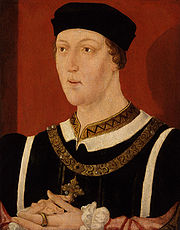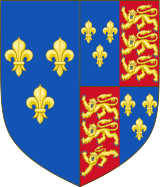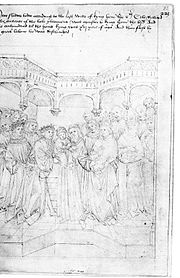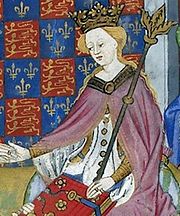
Henry VI of England
About this schools Wikipedia selection
SOS Children have produced a selection of wikipedia articles for schools since 2005. Click here for more information on SOS Children.
| Henry VI | |
|---|---|
 |
|
|
(first time; more...) |
|
| Reign | 31 August 1422 – 4 March 1461 |
| Coronation | 6 November 1429 |
| Predecessor | Henry V |
| Successor | Edward IV |
| Regent | John of Lancaster, 1st Duke of Bedford Humphrey, Duke of Gloucester Henry Beaufort Richard Plantagenet, 3rd Duke of York |
|
|
|
| Reign | 21 October 1422 – October 19 1453 |
| Coronation | 16 December 1431 |
| Predecessor | Charles VI |
| Successor | Charles VII |
|
(second time) |
|
| Reign | 30 October 1470 – 11 April 1471 |
| Predecessor | Edward IV |
| Successor | Edward IV |
| Consort | Margaret of Anjou |
| Issue | |
| Edward of Westminster, Prince of Wales | |
| House | House of Lancaster |
| Father | Henry V |
| Mother | Catherine of Valois |
| Burial | Windsor Castle, Berkshire |
| Signature |  |
Henry VI (6 December 1421 – 21 May 1471) was King of England from 1422 to 1461 and again from 1470 to 1471, and controversial King of France from 1422 to 1453. Until 1437, his realms were governed by regents. Contemporaneously, he was described as a peaceful and pious man, not suited for the harsh nature of the struggles facing him. His periods of insanity and his inherent benevolence eventually led to his own downfall, the collapse of the House of Lancaster, and the rise of the House of York.
Child King
Henry was the only child and heir of King Henry V of England. He was born on 6 December 1421 at Windsor, and succeeded to the throne at the age of nine months as King of England on 31 August 1422, when his father died, and King of France on 21 October 1422 upon his grandfather Charles VI's death in agreement with the Treaty of Troyes in 1420. His mother, Catherine of Valois, was then 20 years old and, as Charles VI's daughter, was viewed with considerable suspicion and prevented from having a full role in her son's upbringing.
On 28 September 1423, the nobles swore loyalty to Henry VI. They summoned Parliament in the King's name and established a regency council until the King came of age. One of Henry V's surviving brothers, John of Lancaster/Plantagenet, Duke of Bedford, was appointed senior regent of the realm and was in charge of the ongoing war in France ( Battle of Cravant, Hundred Years War). During his absence, the government of England was headed by Henry V's other surviving brother, Humphrey, Duke of Gloucester, who was appointed Protector and Defender of the Realm. His duties were limited to keeping the peace and summoning Parliament. Bishop Henry Beaufort (Cardinal after 1426), Henry V's half-uncle, had an important place on the Council. After the Duke of Bedford died in 1435, the Duke of Gloucester claimed the Regency himself, but was contested in this by the other members of the council.
From 1428, Henry's tutor was the Richard de Beauchamp, Earl of Warwick, whose father had been instrumental in the opposition to Richard II's reign.
Henry's half-brothers, Edmund and Jasper, the sons of his widowed mother's relationship with Owen Tudor, were later given earldoms. Edmund Tudor was the father of Henry Tudor, later to gain the throne as Henry VII of England.
In reaction to Charles VII Valois's coronation as French King in Reims cathedral on July 17, 1429, Henry was soon crowned King of England at Westminster Abbey on 6 November 1429, followed by his own coronation as King of France at Notre Dame de Paris on 16 December 1431, although it wasn't until a month before his sixteenth birthday on 13 November 1437 that he obtained some measure of independent authority, before he finally assumed full royal powers when he came of age.
Assumption of government and French policies
Henry was declared of age in 1437, the year in which his mother died, and assumed the reins of government. Henry VI immediately allowed his court to be dominated by a few noble favourites who clashed on the matter of the French war.
After the death of Henry V, England had lost momentum while, beginning with Joan of Arc's military victories, the Valois gained ground. The young king came to favour a policy of peace in France, and thus favoured the faction around Cardinal Beaufort and William de la Pole, Earl of Suffolk, who thought likewise, while Humphrey, Duke of Gloucester and Richard, Duke of York, who argued for a continuation of the war, were ignored.
Marriage to Margaret of Anjou
Cardinal Beaufort and the Earl of Suffolk persuaded the king that the best way of pursuing peace with France was through a marriage with Margaret of Anjou, the niece of the Valois King Charles VII's wife. Henry agreed, especially when he heard reports of Margaret's stunning beauty, and sent Suffolk to negotiate with Charles, who agreed to the marriage on condition that he would not have to provide the customary dowry and instead would receive the lands of Maine and Anjou from the English. These conditions were agreed to in the Treaty of Tours, but the cession of Maine and Anjou was kept secret from parliament. It was known that this would be hugely unpopular with the English populace. The marriage went ahead in 1445.
Henry had wavered in yielding Maine and Anjou to Charles, knowing that the move was unpopular and would be opposed by the Dukes of Gloucester and York. However, Margaret was determined to make him see it through. As the treaty became public knowledge in 1446, public anger focused on Suffolk, but Henry and Margaret were determined to protect him.
The ascendancy of Suffolk and Somerset
In 1447, the King and Queen summoned the Duke of Gloucester before parliament on the charge of treason. This move was instigated by Gloucester's enemies, the Earl of Suffolk, the ageing Cardinal Beaufort and his nephew, Edmund Beaufort, Earl of Somerset. Gloucester was put in custody in Bury St Edmunds, where he died, probably of a heart attack, before he could be tried.
The Duke of York, now Henry's heir presumptive, was excluded from the court circle and sent to govern Ireland, while his opponents, the Earls of Suffolk and Somerset were promoted to Dukes, a title normally reserved for immediate relatives of the monarch. The new Duke of Somerset was sent to France to lead the war.
In the later years of Henry's reign, the monarchy became increasingly unpopular, due to a breakdown in law and order, corruption, the distribution of royal land to the king's court favourites, the troubled state of the crown's finances, and the steady loss of territories in France. In 1447, this unpopularity took the form of a Commons campaign against the Duke of Suffolk, who was the most unpopular of all the King's entourage and widely seen as a traitor. Henry was forced to send him into exile, but Suffolk's ship was intercepted in the English Channel. His murdered body was found on the beach at Dover.
| English Royalty |
|---|
| House of Lancaster |
 Armorial of Plantagenet |
| Henry VI |
| Edward, Prince of Wales |
In 1449, the Duke of Somerset, leading the campaign in France, reopened hostilities in Normandy, but by the autumn had been pushed back to Caen. By 1450, the French had retaken the whole province, so hard won by Henry V. Returning troops, who had often not been paid, added to the sense of lawlessness in the southern counties of England, and Jack Cade led a rebellion in Kent in 1450, calling himself "John Mortimer" in sympathy with York and setting up residence at the White Hart Inn in Southwark (the white hart had been the symbol of the deposed Richard II). Henry came to London with an army to crush the rebellion, but was persuaded to keep half his troops behind while the other half met Cade at Sevenoaks. Cade triumphed and went on to occupy London. In the end, the rebellion achieved nothing, and London was retaken after a few days of disorder, but the rebellion showed that feelings of discontent were running high.
In 1451, the Duchy of Guyenne, held since Henry II's time, was also lost. In October 1452, an English advance in Guyenne had retaken Bordeaux and was having some success but by 1453, Bordeaux was lost again, leaving Calais as England's only remaining territory on the continent.
Insanity and the ascendancy of York
In 1452, the Duke of York was persuaded to return from Ireland, to claim his rightful place on the council and put an end to bad government. His cause was a popular one, and he soon raised an army at Shrewsbury. The court party, meanwhile, raised their own similar-sized force in London. A stand-off took place south of London, with York presenting a list of grievances and demands to the court circle, including the arrest of Edmund Beaufort (the Duke of Somerset). The king initially agreed, but Margaret intervened to prevent the arrest of Beaufort. By 1453, his influence had been restored, and York was again isolated. The court party was also strengthened by the announcement that the Queen was pregnant.
However, on hearing of the final loss of Bordeaux in August 1453, Henry slipped into a mental breakdown and became completely unaware of everything that was going on around him. This was to last for more than a year, and Henry failed even to respond to the birth of his own son and heir, who was christened Edward. Henry possibly inherited his illness from Charles VI of France, his maternal grandfather, who coped with intermittent periods of insanity over the last thirty years of his life.
The Duke of York, meanwhile, had gained a very important ally, Richard Neville, Earl of Warwick, one of the most influential magnates and possibly richer than York himself. York was named regent as Protector of the Realm in 1454. The queen was excluded completely, and Edmund Beaufort was detained in the Tower of London, while many of York's supporters spread rumours that the king's child was not his, but Beaufort's. Other than that, York's months as regent were spent tackling the problem of government overspending.
Wars of the Roses
On Christmas Day 1454, King Henry regained his senses. Disaffected nobles who had grown in power during Henry's reign (most importantly the Earls of Warwick and Salisbury) took matters into their own hands by backing the claims of the rival House of York, first to the Regency, and then to the throne itself.
After a violent struggle between the houses of Lancaster and York, Henry was deposed and imprisoned on 4 March 1461 by his cousin, Edward of York, who became King. By this point, Henry was suffering such a bout of madness that he was apparently laughing and singing while the Second Battle of St Albans raged, which secured his release. But Edward was still able to take the throne, though he failed to capture Henry and his queen, who fled to Scotland. During the first period of Edward IV's reign, Lancastrian resistance continued mainly under the leadership of Queen Margaret and the few nobles still loyal to her in the northern counties of England and Wales. Henry was captured by King Edward in 1465 and subsequently held captive in the Tower of London.
Return to power
Queen Margaret, exiled in Scotland and later in France, was determined to win back the throne on behalf of her husband and son. By herself, there was little she could do. However, eventually Edward IV had a falling-out with two of his main supporters: Richard Neville, Earl of Warwick and his own younger brother George, Duke of Clarence. At the urging of King Louis XI of France they formed a secret alliance with Margaret. After marrying his daughter to Henry and Margaret's son, Warwick returned to England, defeated the Yorkists in battle, and restored Henry VI to the throne on 30 October 1470. However, by this time, years in hiding followed by years in captivity had taken their toll on Henry. Warwick and Clarence effectively ruled in his name.
Henry's return to the throne lasted less than six months. Warwick soon overreached himself by declaring war on Burgundy, whose ruler responded by giving Edward IV the assistance he needed to win back his throne by force. He won a decisive victory at the Battle of Tewkesbury on 4 May 1471, where Henry's son Edward of Westminster, Prince of Wales was killed.
Imprisonment and death
Henry was imprisoned in the Tower of London, where he died on 21 or 22 May 1471. In all likelihood, Henry's opponents kept him alive due to the fact that his death would leave the Lancasters with a much more formidable head in his son Edward, a much more able leader than his father. According to the "Arrivall," an official chronicle favourable to Edward IV, Henry died of melancholy on hearing news of the Battle of Tewkesbury and his son's death. However, it is widely suspected that Edward IV in fact ordered his murder.
William Shakespeare in both Henry VI and Richard III accuses Edward's younger brother Richard of Gloucester (later to become Richard III) of the murder.
King Henry VI was originally buried in Chertsey Abbey; then, in 1485, his body was moved to St George's Chapel, Windsor Castle.
Legacy
Henry's one lasting achievement was his fostering of education; he founded both Eton College and King's College, Cambridge. Continuing an architectural patronage trend begun by his father, these ( King's College Chapel and Eton College Chapel respectively) and most of his other architectural commissions (like his completion of his father's foundation of Syon Abbey) consisted of a single, late Gothic or Perpendicular-style church with a monastic and/or educational foundation attached. Each year on the anniversary of Henry VI's death, the Provosts of Eton and King's College, Cambridge lay white lilies and roses, the floral emblems of those colleges, on the spot in the Wakefield Tower at the Tower of London where the imprisoned Henry VI was, according to tradition, murdered as he knelt at prayer.
Titles, styles, honours and arms
Arms
As Prince of Wales, Henry's arms were those of the kingdom, differenced by a label argent of three points. Upon his accession, he inherited use of the arms of the kingdom undifferenced.
Ancestry
|
|
|
|
|
|
|
|
|
|
|
|
|
|
|
|
|
|
|
|
16. Edward III of England | |||||||||||||||
|
|
||||||||||||||||
|
|
|
|
|
|
||||||||||||
|
|
8. John of Gaunt, 1st Duke of Lancaster |
|
||||||||||||||
|
|
||||||||||||||||
|
|
|
|
|
|
|
|
|
|||||||||
|
|
17. Philippa of Hainault | |||||||||||||||
|
|
||||||||||||||||
|
|
|
|
|
|
||||||||||||
|
|
4. Henry IV of England |
|
||||||||||||||
|
|
||||||||||||||||
|
|
|
|
|
|
|
|
|
|
|
|
||||||
|
|
18. Henry of Grosmont, 1st Duke of Lancaster | |||||||||||||||
|
|
||||||||||||||||
|
|
|
|
|
|
||||||||||||
|
|
9. Blanche of Lancaster |
|
||||||||||||||
|
|
||||||||||||||||
|
|
|
|
|
|
|
|
|
|||||||||
|
|
19. Isabel de Beaumont | |||||||||||||||
|
|
||||||||||||||||
|
|
|
|
|
|
||||||||||||
|
|
2. Henry V of England |
|
||||||||||||||
|
|
||||||||||||||||
|
|
|
|
|
|
|
|
|
|
|
|
|
|
|
|||
|
|
20. William de Bohun, 1st Earl of Northampton | |||||||||||||||
|
|
||||||||||||||||
|
|
|
|
|
|
||||||||||||
|
|
10. Humphrey de Bohun, 7th Earl of Hereford |
|
||||||||||||||
|
|
||||||||||||||||
|
|
|
|
|
|
|
|
|
|||||||||
|
|
21. Elizabeth de Badlesmere | |||||||||||||||
|
|
||||||||||||||||
|
|
|
|
|
|
||||||||||||
|
|
5. Mary de Bohun |
|
||||||||||||||
|
|
||||||||||||||||
|
|
|
|
|
|
|
|
|
|
|
|
||||||
|
|
22. Richard FitzAlan, 10th Earl of Arundel | |||||||||||||||
|
|
||||||||||||||||
|
|
|
|
|
|
||||||||||||
|
|
11. Joan FitzAlan |
|
||||||||||||||
|
|
||||||||||||||||
|
|
|
|
|
|
|
|
|
|||||||||
|
|
23. Eleanor of Lancaster | |||||||||||||||
|
|
||||||||||||||||
|
|
|
|
|
|
||||||||||||
|
|
1. Henry VI of England |
|
||||||||||||||
|
|
||||||||||||||||
|
|
|
|
|
|
|
|
|
|
|
|
|
|
|
|
|
|
|
|
24. John II of France | |||||||||||||||
|
|
||||||||||||||||
|
|
|
|
|
|
||||||||||||
|
|
12. Charles V of France |
|
||||||||||||||
|
|
||||||||||||||||
|
|
|
|
|
|
|
|
|
|||||||||
|
|
25. Bonne of Bohemia | |||||||||||||||
|
|
||||||||||||||||
|
|
|
|
|
|
||||||||||||
|
|
6. Charles VI of France |
|
||||||||||||||
|
|
||||||||||||||||
|
|
|
|
|
|
|
|
|
|
|
|
||||||
|
|
26. Peter I, Duke of Bourbon | |||||||||||||||
|
|
||||||||||||||||
|
|
|
|
|
|
||||||||||||
|
|
13. Joanna of Bourbon |
|
||||||||||||||
|
|
||||||||||||||||
|
|
|
|
|
|
|
|
|
|||||||||
|
|
27. Isabelle of Valois | |||||||||||||||
|
|
||||||||||||||||
|
|
|
|
|
|
||||||||||||
|
|
3. Catherine of Valois |
|
||||||||||||||
|
|
||||||||||||||||
|
|
|
|
|
|
|
|
|
|
|
|
|
|
|
|||
|
|
28. Stephen II, Duke of Bavaria | |||||||||||||||
|
|
||||||||||||||||
|
|
|
|
|
|
||||||||||||
|
|
14. Stephen III, Duke of Bavaria |
|
||||||||||||||
|
|
||||||||||||||||
|
|
|
|
|
|
|
|
|
|||||||||
|
|
29. Elizabeth of Sicily | |||||||||||||||
|
|
||||||||||||||||
|
|
|
|
|
|
||||||||||||
|
|
7. Isabeau of Bavaria |
|
||||||||||||||
|
|
||||||||||||||||
|
|
|
|
|
|
|
|
|
|
|
|
||||||
|
|
30. Bernabò Visconti | |||||||||||||||
|
|
||||||||||||||||
|
|
|
|
|
|
||||||||||||
|
|
15. Taddea Visconti |
|
||||||||||||||
|
|
||||||||||||||||
|
|
|
|
|
|
|
|
|
|||||||||
|
|
31. Beatrice della Scala | |||||||||||||||
|
|
||||||||||||||||
|
|
|
|
|
|
||||||||||||




